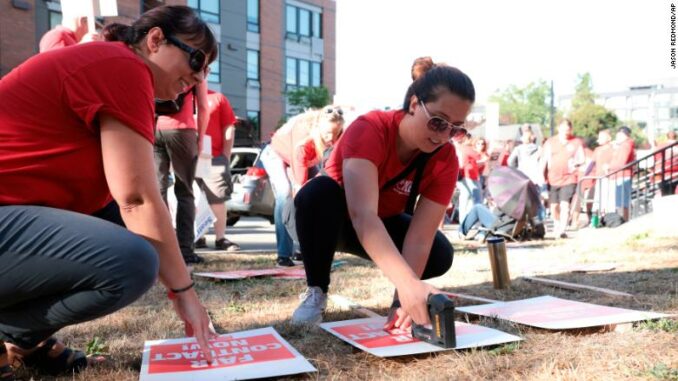Seattle educator-student unity in school strike

As education workers at Seattle Public Schools picket on Sept. 7, the first day of their strike, teachers from neighboring Kent, Washington — who struck their school district Sept. 1 — assemble signs in solidarity.
Seattle
A five-day strike by the Seattle Education Association (SEA) produced gains for the district’s 6,000 educators and 50,000 students. Despite rhetoric from the district management against the strike, the educators walked out Sept. 7, the scheduled first day of school. Now a tentative agreement has been reached as educators headed back to work Sept. 14.
After the tentative agreement was reached Sept. 13, the SEA members voted 57% to 43% to suspend their strike until the members could vote on ratification. The vote to suspend was taken after an eight-hour membership zoom meeting. Highlights of the agreement have been distributed to members for a final vote.
The strike came as part of an upheaval of workers everywhere who have had enough of cutbacks and worker oppression and exhaustion. Mass picketing with full participation increased unity between teachers, education worker staff, students and parents. The SEA had the experience of a 2015 strike during the national “strike wave” of education workers.
The leadership of Seattle Public Schools seemed to be taking a cue from the union-busting tactics of locally headquartered Amazon and Starbucks monopolies. SPS management refused to propose anything but take-backs from what the union had previously won.
The overriding issues of the strike dealt with shortages of teachers and education staff workers. Not only has the administration failed to adequately provide for education during COVID-19, but previous years of cutbacks have damaged public schools.
Another key demand in SEA’s strike was more support for special education students, many of whom are disabled. The lack of funding for disabled students has been a scandal in the school district going back decades.
A summary of the SEA’s wins in the tentative contract include the following: Educators struck for and gained specific staffing ratios for special needs students. The agreement provides workplace protections for teachers, school counselors, nurses and social workers. There are to be increased benefits for substitute teachers. The district agreed to provide teachers with interpreters and translator services for meetings with multilingual parents.
The teachers won a 7% pay increase, although 5.5% of that is automatically provided by the state to all schools for inflation adjustment.
SEA Vice-President and bargaining chair Uti Hawkins emphasized that even with the new contract, the union has to continue to fight to recruit and retain people, as high costs make living in Seattle untenable. (Seattle Times, Sept. 14)
With superhigh housing costs, many educators can’t afford to live in Seattle. In a city with megabillionaires like Bill Gates, Jeff Bezos and Starbucks’ Howard Schultz, Seattle Public Schools’ story that it doesn’t have enough money was absurd.
The education workers have built bonds of solidarity in the strike. The Parent Teacher Student Association and the newly formed Seattle Student Union both came out in support. At Franklin High School, there was an active picket line with chants all day; the pedestrian overpass was decorated with pro-union banners, and there were continuous honks from vehicles.
The picket line discussions with educators, students and parents have brought more understanding of the issues workers face in their struggle.

